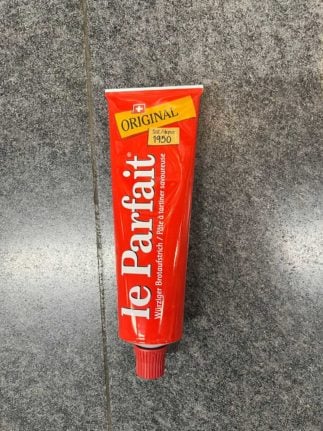When Freiburg student Claude Blancpain sought healthy food options in the early 1940s – in a time when both fresh produce and meat were rationed – he was happy to discover that the readily available yeast packed a nutritional punch.
This quickly gave him an idea: create a spread that replaces meat with yeast and animal fat with more easily digestible vegetable matter.
Claude thus went on to create two exclusively plant-based spreads, Dyna SA and TARTEX, in 1942, but despite their initial success, sales stalled as World War II came to an end and with it, prosperity returned. The Dyna spread duo quickly became known as a substitute food from the war that nobody wanted a reminder of.
Yet, Claude wasn’t deterred. In 1949, he joined forces with chemist Erwin Haag and cooked up a whole new recipe – this time including meat. When the pair presented the finished product to his wife on New Year’s Eve 1949, it didn’t take many bites before Madame Blancpain enthusiastically exclaimed “C’est parfait!” – and Le Parfait was born.
Overnight success
Le Parfait, a welcome and inexpensive alternative to cheese and jam, quickly became immensely popular throughout Switzerland, garnering cult status in the country akin to Ovomaltine and Aromat in the 1960s and 1970s.
In 1962, the tin cans were replaced with the popular red tubes loved across Switzerland today and a decade later, Nestlé took over Dyna SA and put the finishing touches on the Le Parfait recipes. In addition to the original, Nestlé has since launched other varieties, such as chicken, tuna, and herbs.

Recipe
Many an adult Swiss today will vividly recall the day they found out just what is hidden inside their beloved red tube – and for many, it’s a cause for nightmares.
The recipe contains many ingredients, most of which are perfectly innocent. Yeast, water, salt, starch potato and sunflower oil all make up this fantastic spread.
Le Parfait also contains maltodextrin (from cornstarch), modified maze starch, horns of plenty mushrooms, spices, herbs extracts and perhaps the slightly controversial palm kernel fat.
But the real horror lies in the remaining 12.2 per cent that constitute the recipe: mashed up pork liver. Not surprisingly, Le Parfait is a child favourite for a reason.
Bread and paste
From incorporating it in a beef wellington to making tasty mushroom bruschetta with a Le Parfait twist – there are many sophisticated ways to eat Switzerland’s top spread. Nevertheless, the most popular (and Swiss) way of eating Le Parfait is without a doubt the simplest.
Simply grab a slice of fresh Swiss bread and squeeze out a generous amount of the paste. Some people also like to add butter to their bread or eat the spread with a plain cracker topped with pickles.
Note: Gently roll the tube from the top to the bottom to squeeze out the yummy spread. Remember to refrain from pressing it in the middle – even if you’re starving. The tube is known to pop!
Not so Swiss anymore?
The red tube may very well feature the Swiss cross, but Nestlé outsourced the traditional product’s production – which used to take place in a factory in Basel – to Liechtenstein in 2021. Le Parfait is now manufactured by the Ospelt Group in Bendern, Liechtenstein which, strictly speaking, means it is no longer a purely Swiss product.
Still, the Swiss cross is justified. But why?
According to the Swissness law (yes, that’s a real thing), a product can only call itself a true Swiss if it consists of at least 80 per cent raw materials generated from Switzerland. Milk and milk products, however, must be 100 per cent produced in Switzerland to be considered Swiss.
Additionally, the main manufacturing stage must also have taken place in Switzerland.
According to Switzerland’s Federal Office for Agriculture (FOAG), Le Parfait can – despite being wholly produced in Liechtenstein – bear the Swiss cross because of the special regulations for goods from the bordering country.
Liechtenstein is considered a customs union area and hence, on equal footing with Switzerland when it comes to Swissness. This, because exact demarcations in border areas can often be difficult to determine, so Liechtenstein enjoys a special – Swiss – status, which luckily also applies to Le Parfait.



 Please whitelist us to continue reading.
Please whitelist us to continue reading.
Member comments